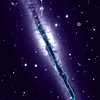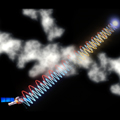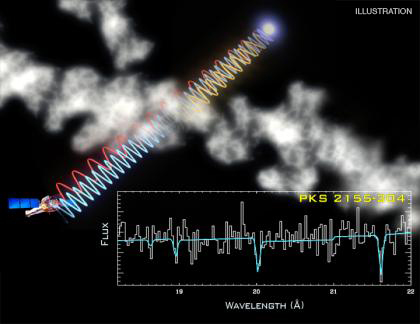Intergalactic Hot Gas
J.Bregman & J.Irwin)
Chandra Discovers "Rivers Of Gravity" That Define Cosmic Landscape
Four independent teams of scientists have detected intergalactic gas with temperatures in the range 300,000 to 5 million degrees Celsius by observing quasars with the Chandra X-ray Observatory. An artist's rendering illustrates how X-rays from a distant quasar dim as they pass through a cloud of the intergalactic gas. By measuring the amount of dimming due to oxygen and other elements in the cloud - see the spectrum of the quasar PKS 2155-304 in the inset - astronomers were able to estimate the temperature, density and mass of the absorbing gas cloud.
Observations of PKS 2155 and the quasar H1821+643 by an Ohio State group revealed various parts of the hot gas system. One of these appears to be a filament in which the Milky Way and Andromeda galaxies are embedded, whereas other detected portions are at distances of a few billion light years from Earth.
The hot gas, which appears to lie like a fog in channels carved by rivers of gravity, has been hidden from view since the time galaxies formed. It is thought that this gas forms part of a gigantic system, or web, of hot gas and dark matter that defines the cosmic landscape. The hot gas part of this system could contain more material than all the stars in the universe. Ultraviolet telescopes had detected cooler components of the hot gas system, but most of it is now known to be detectable only with an extremely sensitive X-ray telescope.
The hot gas detected by Chandra can be used to trace the more massive dark matter component. Eventually, astronomers will be able to use the hot gas to map of the distribution of dark matter in the universe and perhaps understand its origin.
|
||||||||||||||||||||||
This image depicts an illustration of the intergalactic gas cloud in front of quasar PKS 2155-304, which is a galaxy with a powerful supermassive black hole located in the constellation of Cygnus. The graphic consists of two components: an artist's illustration of the gas cloud and a quasar on the upper left and a graph on the lower right. The gas cloud appears as a greyish, swirling mass that dominates the center of the image. Its texture can be described as wispy and nebulous, reminiscent of clouds in the sky on a stormy day. The quasar is depicted as a bright, blue source towards the upper right middle of the image. The graph or chart provides a visual representation of data related to the quasar's brightness over time. It features a series of four valleys, indicating fluctuations in the quasar's luminosity. By measuring the amount of dimming due to oxygen and other elements in the cloud - see the spectrum of the quasar PKS 2155-304 in the inset - astronomers were able to estimate the temperature, density and mass of the absorbing gas cloud. The hot gas, which appears to lie like a fog in channels carved by rivers of gravity, has been hidden from view since the time galaxies formed. It is thought that this gas forms part of a gigantic system, or web, of hot gas and dark matter that defines the cosmic landscape. The hot gas part of this system could contain more material than all the stars in the universe. Ultraviolet telescopes had detected cooler components of the hot gas system, but most of it is now known to be detectable only with an extremely sensitive X-ray telescope.






